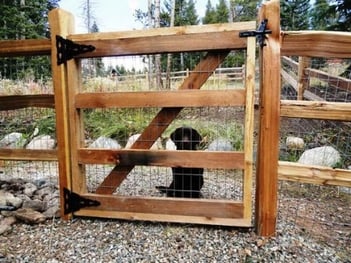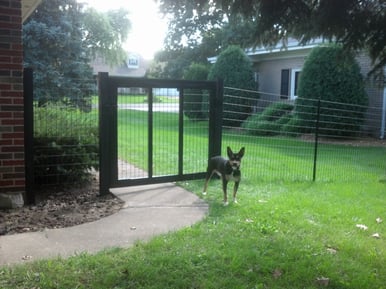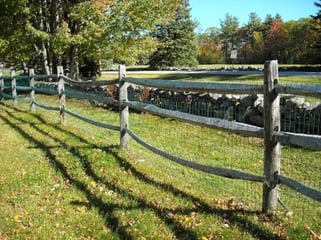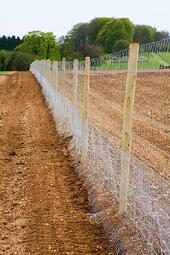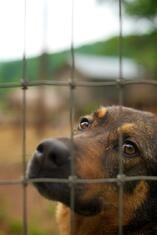Safe Pups and Their People
There is no use in putting off the repair or construction of a fence if you're a dog owner. Most obviously, keeping your dog safely away from the street is paramount. A fenced-in yard allows a dog to run, jump, and play, offering life-enhancing exercise. A fence allows a dog to safely do what a dog must do: employ their senses--smelling, chasing rodents, and guarding the house from passersby (without incident), to name just a few. This activity is an essential aspect of a dog's life and health, and a fence offers a measure of freedom, for you and your dog. A well-surrounded backyard doesn't preclude the need for the joy of fido's joys--being walked--that roam around the neighborhood to broadcast his essential message: I'm here and it matters.
Which Type of Fence?
- Chain-link or large openings
Efficient for some things, but sadly often dangerously climbable--a medium or large size dog can easily gain a foothold and get over a fence. Chain-link also won't win you any points with neighbors aesthetics-wise either. If your dog is a climber (see the video below), gaining a foothold is possible with other styles of fence, too--call Louis Page for advice on the right-sized openings.
- Electric
An invisible fence might solve the boundary and aesthetic issues, but for a dog, the shock can be received as a punishment, when delivered it can be misconstrued with whatever the dog is perceiving at the time of the shock so fears can result. And it can in some cases be breached if the incentive is great enough.
- Apron
A great option for medium and some large dogs, especially if your dog is a digger. This line wire, running the length of the roll, acts as a guide for bending or folding the bottom 12 inches of the roll to create an apron. When folded at a 90-degree angle, this part of the fence lays on the ground. Grass or vegetation will grow up through the apron, securing the hexagonal mesh to the ground. This eliminates the need for the digging of a trench and burying wire in the ground--nice chores to avoid. When your dog comes up to the edge of the vertical fence and starts digging, the wire mesh stops them. To keep your dog within the enclosed area, place the apron to the inside and the apron will prevent digging under the fence.
Very helpfully, your fence...
- lessens the number of times a day a dog must be walked
- is a good substitute for a trip to the dog park (particularly if your dog is aggressive with other dogs)
Please also remember: even your dog can be unpredictable and this fence quite crucially:
- Protects others
- Guards against injury, awkward mishaps, and unfortunate encounters
- Keeps you from liability issues
- Wards off intruders, accompanied by your dog's bark, of course
Height is important--if you have a big dog, a 4-foot fence will not suffice. Anywhere from 5 to 7 feet is required depending on the size and agility of your breed. For smaller breeds, four feet should do the trick unless you have a dog who is Captain Marvel and should be wearing a cape.
- Walk around the yard and make sure there's nothing that would give a leg up and help a dog escape, like stacks of debris or wood
Adapting Your Existing Fence
Here's a solution from Down Under:
Ground/Sod Staples
If you've got a digger, add some heavy 8 gauge wire staples (also known as U pins) to an existing mesh fence. They're 8 inches long with 1" spacing between prongs. Ground staples are a cinch to drive into the soil and are long enough to secure the fence. Use these handy stakes to firmly keep the bottom of the fence flat to the ground. Good to use when you want to keep your pup or other animals from getting under a fence.
A Secure Backyard
And once behind the fence, alleviating boredom with your presence is the greatest reward for a dog who desires your companionship and leadership. Activities behind the fence may include training exercises or teaching tricks, throwing a ball or playing Frisbee, using toys, (and then swapping out the toys to maintain interest) with breaks from being fenced in. Hiding a favorite treat or toy to discover in the backyard can give an opportunity for distraction. If a grooming session is something that your dog enjoys, do it in the yard so positive associations are made.
→Remember that herding or sporting breeds need more distractionCall Louis Page and talk with us about your dog and the particulars of your property and we will advise you as to the best style and grade of fence for your situation. We'll help take the guesswork out of creating the right enclosure for your four-legged best friend.
And finally, depending on your dog's agility (and desperation) there are some common but questionable choices out there:


